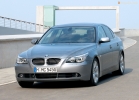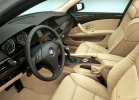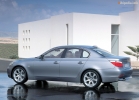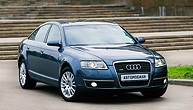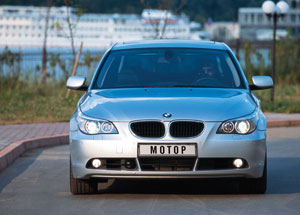Test drive BMW 5 series E60 2003 - 2007 sedan
Black BMW
BMW 5th series: prestigious sedan for every day and many yearsBMW cars love in Russia. Even more. A couple of years ago, a film was shot about one of the models of a Bavarian concern, and now Serega boasts in a popular song that he has a black BMW and all local girls love to ride it. Still, because even a used BMW can afford far from everyone. Especially when it comes to five in the body of the E39, produced from 1995 to 2003.
As a rule, the BMW 5 series sold in our secondary market has a sedan body. The station wagons, which appeared only in 1997, are extremely rare. A pity, because the station wagon on the basis of the five looks very harmonious and even stylish. True, it costs, as a rule, more expensive than the sedan similar in configuration and technical condition. Moreover, this difference can be several thousand dollars. And the point is not only that the production of station wagons takes more material. Many turlahs are equipped with a pneumatic rear suspension, which automatically levels the body depending on the load.
And it must also be mentioned that the BMW of the 5th series in the E39 body was collected not only in Europe, but also in Russia - since 1999, five began to be done in Kaliningrad. Sometimes you can hear that these machines can not be compared in quality with products made in Germany. But this is not so. In their reliability, the Russian BMW is not inferior to their German counterparts. Kaliningrad boomers have two packages - for bad roads and for cold countries (since September 1998), which is expressed in the presence of reinforced shock absorbers, other springs and stabilizers, engine protection, etc. All this can be put on cars from Europe, but this one will cost this Doucial education of more than $ 1200. Therefore, many buyers of European five prefer the first time to limit themselves to only a strong metallic protection of the crankcase for about $ 160 - without it, on our roads in two accounts, you can damage the engine pallet. And when preparing a machine for Russian conditions, German engineers decided to change the whereabouts of the air intake, which is located on the Kaliningrad machines not in the front bumper, but a little higher. Thanks to this, the risk of a hydraulic jacket has significantly reduced.
Not a single lousy sheep
A total of 14 different modifications of power units were installed on the five E39, in which even a specialist can get confused. Let's start with 6-cylinder gasoline engines. Until 2000, five were equipped with 2.0 liter engines with a capacity of 150 hp. (BMW 520i), 2.3 l with a capacity of 170 hp (BMW 523i) and 2.8 l with a capacity of 193 hp (BMW 528i). You can often hear that the 2-liter power unit is not too suitable for the 5th series, but this statement is debatable, because such cars are easily accelerated to 220 km/h. Agree, not so little. But versions 523i and 528i are unlikely to call someone dead. These are almost perfect fives, because 2.3- and 2.8-liter engines have power, reliability, and besides, their price is more affordable compared to cooler V8. Well, after modernization, even among 6-cylinder engines there was not a single lousy sheep, which, albeit with a stretch, could be ranked not powerful enough. So, version 520i received a 2.2 liter motor (170 hp). In addition, the BMW 525i and 530i appeared with 6-cylinder units with a volume of 2.5 and 3.0 liters with a capacity of 192 hp. and 231 hp respectively.
Well, the one who needs not just a car, but a real rocket, should look for five with 8-cylinder engines. There were two of them, with a volume of 3.5 and 4.4 liters, with a capacity of 245 hp. and 286 hp respectively. A unique 4.9-liter unit, which developed a breathtaking 400 hp, could also be added here, but it was put on the BMW M5 version, which is seriously different from ordinary five and worthy of a separate article.
You can’t pass by diesel engines. There are few of them in our secondary market, but these motors are worthy of respect. On the five you can find diesel engines with a volume of 2.0 liters (136 hp), 2.5 l (143 hp or 163 hp) and 2.9 l (184 hp or 193 l. With.). Diesel BMW, especially with engines more powerful, are good for everyone, however, with one great exception - at 90%, if not in 100% of cases they have very large runs. Indeed, in Europe, these cars were acquired only by those drivers who drive a lot - believe me, annually such cars roll about 50 thousand km or more. And as a result, after 5-7 years of operation, 250-400 thousand km behind their shoulders. No matter how good German engines are, but by this moment they are usually seriously worn out. And the repair of diesel engines costs a lot of money (finding a used in decent state is unrealistic). And the diesel fuel in Russia is also not super. In general, the old diesel BMW is still better not to purchase.
Dangerous options
There are dangerous fives with gasoline engines. And here we are not talking about volume. Sometimes cars (made until September 1998) with engines with nickel-cream (Nikosilovo) coating of cylinders are found on sale. This very Nikosil is destroyed over time, and the cylinder block must be changed. I must say that BMW quickly realized that she had made a big mistake, deciding to use this nasty drug. And in many cases, Nikosille engines were replaced by warranty with new ones that have already covered from reliable alusil. But nicosilov units are still found, and in this case, when breaking the engine, you must either give about $ 3000 per new block, or use the inserts from cast iron, which is also not cheap. Moreover, many masters doubt the effectiveness of the last operation. Therefore, when buying a car, it is necessary to go to the BMW service, and using an endoscope, check the cylinder block (nicosille coating differs in color from alusille).
Also, when buying, you need to find out if the engine has been subjected to overheating, which can lead to very expensive repairs. To prevent no overheating, it is necessary to clean the radiator once a year, for which you have to remove the bumper, and also monitor the cost of the thermom factor of the fan turnover (its replacement will cost about $ 120-200) and the pump (the latter sometimes turns the plastic impeller, which leads to the costs in the amount of about $ 60-100). Another relatively weak place in the cooling system is the thermostat (its replacement costs $ 50-100 with spare parts). And it happens that the engine begins to warm up due to the broken air conditioner radiator fan (is in front of the main one). It must be said that the above breakdowns are quite rare, but these places deserve close attention so as not to become a victim of murderous overheating.
During the operation of the BMW of the 5th series, it is recommended to call on the service to change the oil, not when the computer says (the five is equipped with such a system), and a little earlier-it is better every 12-15 thousand km. Of course, the oil should only be of better quality, and it is necessary to use the manufacturer exclusively recommended by the factory (by the way, at the same time, the masters are strongly not advised to pour flushing into the motor). But to remember about the delicate timing belt in the case of the BMW of the 5th series is not necessary - all five -five motors have a chain that is enough for 250 thousand km or more. And it is better to spend saved money on the cleaning of nozzles (every 50-80 thousand km) with special drugs on the BMW service. Most likely, at the same time, candles will have to be changed at the same time (they cost $ 15-20 apiece).
According to the masters, the BMW E39 engines have established themselves as very reliable. And in those cases when this or that petty repairs should be done, it is often possible to avoid too much costs thanks to the use of good non -original details. But what should really be afraid of is the capital - it is very expensive. So before purchasing the five, it is necessary to carry out the most thorough diagnostics of the engine. The $ 50-100 spent on this cannot be compared with the costs that will bring a serious breakdown of the engine. For example, the repair of the proprietary system for changing the Vanos gas distribution phases, which is required after 200-300 thousand km of run, will cost $ 300-600 (with wear of the coolest Double Vanos, the costs will be much more).
To the envy of competitors
All versions of the BMW of the 5th E39 series could have both a mechanical and automatic gearbox. Moreover, starting from the end of the 90s, the machine gun had the possibility of manual switching, which made it possible to combine the advantages of both types of transmission. The boxes on the top five are very reliable and are able to work no less than the engine itself. Only you need to ensure that the oil does not leave them (with large runs, it can begin to seep through the seals, but their replacement usually costs $ 50-100). Clutch on machines with mechanics has a good resource and works 150-200 thousand km (lovers of quick starts, of course, kill it faster). The clutch kit costs about $ 350-400, and for its replacement at a regular STO they will take about $ 70-120.
When creating the BMW of the 5th series, the engineers decided to actively use aluminum, which helped reduce the total weight of the car, as well as reduce the unsubstantiated masses. On the five E39, the front axle beam, the transverse levers and the guides of the shock -absorbing rack are completely made of aluminum. The rear suspension is taken from the large seven and has its own company name - Integral IVA. And the rear suspension, thanks to its design, can steal a little on the bends, helping the driver get more riding pleasure.
Despite all the conversations about the inappropriation of fast BMW to Russian roads, one can say one thing - the fifth suspension is reliable. As experience shows, most often replacements require a stabilizer rack (both in front and behind), but they are inexpensive - from $ 15 to $ 30, depending on the place of purchase and the manufacturer. It is worth noting here that most of the details of the chassis of the BMW of the 5th series do not have to buy in the original performance. Almost always you can find exactly the same elements, but in the box Lemferder or some other company (specialists in spare parts stores are well aware of this).
BMW drivers of the 5th series should remember that for each it is necessary to not only change the oil, but also carefully inspect the suspension, blow the drainage holes under the hood, etc. And if there are the slightest doubts about the correctness of the work of a particular part, it is better immediately Change. Otherwise, one worn out element will quickly get into the grave and others. As a result, the cost of repairs will not be $ 100, but $ 500. As often happens, the front suspension requires more attention, where each wheel accounts for two levers ($ 130 Lemferder production and $ 170 original). If you ride without noticing the pits and the pardon, they are killed for 15-30 thousand km. But it is worth being a little more careful, like levers with ball supports and silent blocks, 70-80 thousand km work without problems. Although in many cases, the silent blocks of the upper levers wear out much earlier, but, fortunately, they change separately (the price of the part is $ 12-20).
The rear suspension is reliable, but by car over 5 years it may require replacing the silent block in the hub, which is sometimes called steeringry or floating ($ 40-70), as well as the so-called integral lever ($ 26). A little less often you have to change two more simple levers ($ 120 apiece). But the most unpleasant thing is when Silent-Blok wears out in a large N-shaped lever.
In this case, you have to buy a lever assembly. It is only original ($ 340). The brakes of the car work as expected. It happens, however, that the ABS sensors or the system control unit are out of order. And if a new sensor costs about $ 120, then $ 950-1000 will have to be given for an electronic unit! But here it should be noted that there are no more problems with the ABS control unit on the five, made after 1999. By the way, after 1999, steering racks on cars with in-line engines became more reliable (a different steering costs BMW with the 5th series with V8 engines). Buying a car with a faulty rail can ruin $ 1200 in the future! So be careful.
Text: Denis Smolnov.
Source: Mkobil magazine [13.06.2005]
Video test drives BMW 5 Episode E60 2003 - 2007
Video Crash tests BMW 5 series E60 2003 - 2007
Test drives BMW 5 series E60 2003 - 2007
Crash Test BMW 5 Episode E60 2003 - 2007
Krassh Test: Detailed Information29%
Driver and passengers
2%
Pedestrians
42%
Children-passengers
Malfunctions BMW 5 E60 2003 - 2007
BMW 5 series of sedan: Detailed information| Episode 5 E60 2003 - 2007 | |
|---|---|
| Engine |  |
| Transmission |  |
| Control system and suspension |  |
| Brake system |  |
| Air heating and air conditioning |  |
| Launch and charging system |  |
| Electric components and so on |  |
| Corrosion body stability |  |

